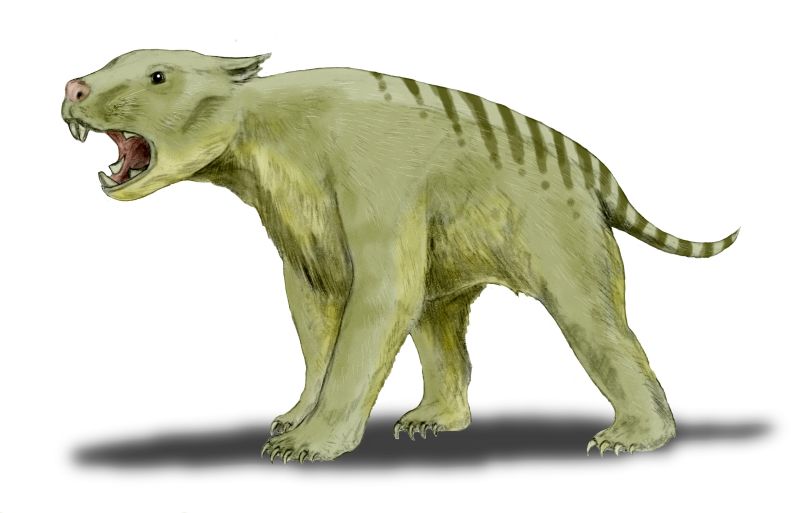- Thylacoleo
Taxobox
name = "Thylacoleo"
fossil_range = latePliocene —latePleistocene

regnum =Animal ia
phylum = Chordata
classis =Mammal ia
infraclassis =Marsupialia
ordo =Diprotodontia
familia =Thylacoleonidae
genus = "Thylacoleo"
genus_authority = Owen, 1859
subdivision_ranks =Species
subdivision =
*"Thylacoleo hilli "
*"Thylacoleo crassidentatus "
*"Thylacoleo carnifex ""Thylacoleo" ("Pouch Lion") is an
extinct genus of carnivorousmarsupial s that lived inAustralia from the latePliocene to the latePleistocene (2 MYA to 30,000 years ago). Some of these "marsupial lions " were the largestmammal ian predators in Australia of that time, with "Thylacoleo carnifex " approaching the weight of a smalllion .There are many similarities between prehistoric
Australian megafauna and some mythical creatures from the aboriginal dreamtime fact|date=June 2008.Description
Pound for pound, "Thylacoleo carnifex" had the strongest bite of any
mammal species living or extinct; a kg to lb|100|abbr=yes|wiki=yes|precision=0 "T. carnifex" had a bite comparable to that of a kg to lb|250|abbr=yes|precision=0 African Lion [ [http://news.bbc.co.uk/2/hi/science/nature/4409039.stm BBC NEWS | Science/Nature | Marsupial munch tops big biters ] ] and is thought to have hunted large animals such as "Diprotodon " spp. and giantkangaroo s. It also had extremely strong forelimbs, with retractable catlike claws, a trait previously unseen in marsupials. "Thylacoleo" also possessed enormous hooded claws set on large semi-opposable thumbs, which were used to capture and disembowel prey. The long muscular tail was similar to that of a kangaroo. Specialized tail bones called chevrons allowed the animal to tripod itself, and freed the front legs for slashing and grasping. [ [http://www.pbs.org/wgbh/nova/bonediggers/thyl-nf.html NOVA | Bone Diggers | Anatomy of Thylacoleo | PBS ] ]Its strong forelimbs, retracting claws and incredibly powerful jaws mean that it may have been possible for "Thylacoleo" to climb trees and perhaps to carry carcasses to keep the kill for itself (similar to the
leopard today). Due to its unique predatory morphology, scientists repeatedly claim "Thylacoleo" to be the most specialized mammalian carnivore of all time. [ [http://news.nationalgeographic.com/news/2004/03/0305_040305_TVsuperpredator.html Extinct Australian "Lion" Was Big Biter, Expert Says ] ]"Thylacoleo" was cm to in|71|abbr=yes|wiki=yes|precision=0 at the shoulder and about cm to in|114|abbr=yes|precision=0 long from head to tail. The "T. carnifex" species is the largest, and skulls indicate they averaged kg to lb|101|abbr=yes|precision=0 to kg to lb|130|abbr=yes|precision=0, and individuals reaching kg to lb|124|abbr=yes|precision=0 to kg to lb|160|abbr=yes|precision=0 were common. [cite journal|author = Wroe, S., Myers, T. J., Wells, R. T., and Gillespie, A. | year = 1999 | title = Estimating the weight of the Pleistocene marsupial lion, "Thylacoleo carnifex" (Thylacoleonidae : Marsupialia): implications for the ecomorphology of a marsupial super-predator and hypotheses of impoverishment of Australian marsupial carnivore faunas | journal = Australian Journal of Zoology | volume = 47 | pages = 489–498|doi = 10.1071/ZO99006]
Discoveries
"Thylacoleo" was first described by Sir
Richard Owen in 1859.Fact|date=February 2008In
2002 , a remarkably complete skeleton of "T. carnifex" was discovered in a limestone cave underNullarbor Plain , where the animal fell to its death through a narrow opening in the plain above. [ [http://news.bbc.co.uk/2/hi/science/nature/6296029.stm BBC News, "Caverns give up huge fossil haul", 25 January 2007] .]Taxonomy
Family:
Thylacoleonidae (Marsupial lion s)Marsupial "lion" alludes to the superficial resemblance to the placental lion and its ecological niche as a large predator. "Thylacoleo" is not related to the modern lion "Panthera leo".
Genus: "
Thylacoleo " ("Thylacopardus") - Australia's marsupial lions, that lived from about 2 million years ago, during the late Pliocene and became extinct about 30,000 years ago, during the late Pleistocene epoch.*"Thylacoleo hilli" (
Oligocene , Pliocene)
*"Thylacoleo crassidentatus" (Pliocene)
*"Thylacoleo carnifex " (Pleistocene)The family it belonged to, the Thylacoleonidae, has fossil representatives (e.g. "
Priscileo " and "Wakaleo ") dating back to the late Oligocene, some 24 million years. [cite book | author = Long, J.A., Archer, M., Flannery, T. & Hand, S. | year = 2002 | title = Prehistoric Mammals of Australia and New Guinea - 100 million Years of Evolution | publisher = Johns Hopkins University Press | location = Baltimore | pages = 224pp]References
ee also
*
Naracoorte Caves National Park External links
* [http://www.naturalworlds.org/thylacoleo/index.htm Thylacoleo - Australia's Marsupial Lion]
* [http://www.thylacoleo.com/thylacoleo.html Thylacoleo in Pleistocene Australia]
* [http://www.bio.usyd.edu.au/staff/swroe/swroe.htm Steve Wroe's Web Page: Australian Megafauna]
* [http://www.cnn.com/2007/TECH/science/01/25/australia.fossils.reut/index.html BBC: Mega-marsupials once roamed Australia]
Wikimedia Foundation. 2010.
